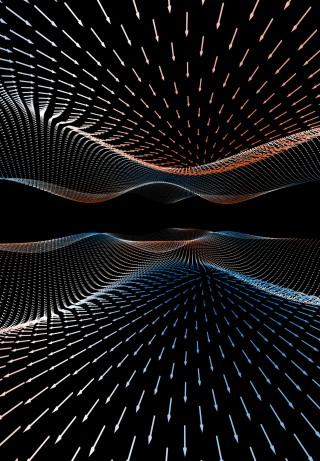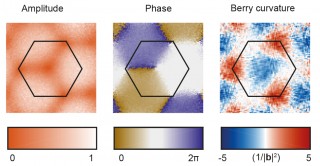The research group of CUI member Prof. Klaus Sengstock (Universität Hamburg) has for the first time succeeded in measuring the Berry curvature in a lattice system. Thus a fundamental building block in our understanding of topological matter becomes experimentally accessible. In the long run, research on topological matter is important for quantum information processing. The scientists have just published their results in Science.

Illustration of the calculated geometry of the eigenstates of two Bloch bands. Credit: Benno Rem / Gruppe Prof. Klaus Sengstock
The wave nature of particles at the atomic scale leads to many microscopic properties, which are difficult to understand by intuition. Furthermore, certain phenomena in macroscopic solid states or systems can only be understood by quantum physics, for example magnetism, superconductivity and superfluidity. One research focus in this area is the exploration of exotic phenomena that are governed by special topological properties. Among these are the Quantum Hall effect, topological superfluids or topological insulators, which only conduct at their edges. For studying the topological nature, ultracold atoms in optical lattices are a suitable system, because their properties can be controlled and varied with high precision. Next to the band structure, the structure of the Bloch eigenstates of the lattice plays an important role. Their geometry is described by the Berry curvature, from which quantities like the Berry phases or the Chern number can be obtained. The latter determines the topology of the system and has vital consequences, such as quantized chiral edge states, which are responsible for the quantized conductance in the quantum Hall effect.
“In recent years, topological insulators and spin-Hall systems were in the focus of interest, because they form a new class of matter with possible applications in quantum information processing,” says the scientific coordinator of the group, Dr. Christof Weitenberg. Although these systems have been studies intensively, it has previously not been possible to measure the geometry of the eigenstates and the resulting Berry curvature across the full Brillouin zone.

Experimental data obtained from the tomography and Berry curvature. Credit: Benno Rem / Gruppe Prof. Klaus Sengstock
Weitenberg and his colleagues now observed the dynamics of the interfering states after a sudden quench of the lattice parameters and used it to develop a new detection method. Finally, they obtained a fully momentum-resolved tomography of the eigenstates in a hexagonal optical lattice and extracted the corresponding Berry curvature and Chern number.
Moreover, the researchers are able to manipulate the topology of the lattice system and to move the Dirac points via periodic shaking. The method is suitable to study the effects of interactions on the topology or the dynamics in topological lattice systems.
“Our method opens up totally new possibilities to make such influences directly experimentally accessible,” says Prof. Klaus Sengstock and explains further: “This will greatly advance our understanding of topological matter.”
Citation:
Fläschner N., Rem B. S., Tarnowski M., Vogel D., Lühmann D.-S., Sengstock K., Weitenberg C.
“Experimental reconstruction of the Berry curvature in a Floquet Bloch band”
Science, Vol. 352, Issue 6289, pp. 1091-1094 (2016)
DOI: 10.1126/science.aad4568

